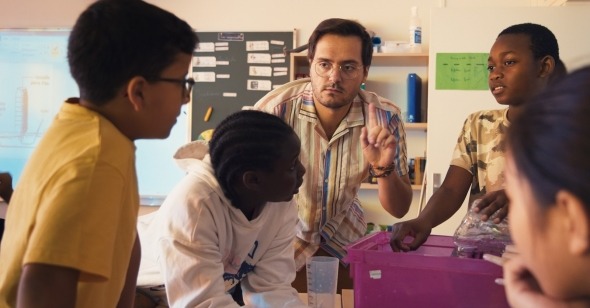Look Out, World
By Dan Schindel
Elementary
Dir. Claire Simon, France, no distributor
Elementary plays March 16 at Museum of the Moving Image as part of First Look 2025.
Claire Simon is often compared with Frederick Wiseman—they’ve operated in similar modes of documentary observation, superficially unobtrusive but exacting in the details they alight on. There are more distinctions than overlaps, though. Simon does not adhere to a formal rigidity the way Wiseman does across his work. In her latest, Elementary, which follows the goings-on at a public school in the Paris suburbs, she mostly acts as a silent watcher, but she breaks that conceit to inquire with a teacher about how she handles an autistic pupil who’s taking a reprieve in the yard. The film freely switches between a subjective, often handheld child’s-eye point of view and still cameras positioned at the eyeline of adults—implicitly, a parent or teacher, the position of authority. That aesthetic looseness feels like an appropriate evocation of the anything-goes sensibility of childhood, as well as the pedagogical nature of the educational milieu.
I thought about Wiseman in the context of Elementary not merely because of the formal parallels between his and Simon’s work, but because I had recently seen the restoration of Wiseman’s High School (1968). The films’ respective schools are drastically different, of course—one we are seeing as it was nearly 60 years ago while the other is contemporary, one is full of preteens and the other adolescents, one is American and the other French, one is almost all white and the other serves an ethnically mixed community. But both movies investigate how these institutions are structured less to impart the hard facts of science, math, and history than they are to shape the youth into the adults that society expects them to be.
The distinctions are illuminative. High School exemplifies a prescriptive approach to education in which students are herded into specific roles—there is a repeated emphasis on how the young people are taught and act out gender through sequences about sex education, a girl being scolded for not wearing a bra, or the football team wearing cheerleader outfits as a gag. In Elementary, the teachers adopt a gentler approach, focusing on their charges becoming well-socialized, adjusted, and respectful of others’ points of view and personal space. It’s not hands off—they are proactive in everything from handing out “red cards” for overly rough behavior during recess to helping kids work through their multiplication tables—but the adults are often aiding the students in learning how to think rather than enforce what to think upon them. A scene in which two boys play checkers exemplifies this; the teacher explains the rules of the game but does not intervene to enforce them, instead letting the two work things out themselves.
One should not mistake this necessarily as proof of one time or place’s supremacy over the other. There were schools that imparted lessons like the one in Elementary in America during the ’60s, just as there are schools in France today that are more like the one in High School. And these films are in dialogue not just with each other but also the broader corpus of media about education, which includes the ecosystem of news stories fixated on the lives and beliefs of students. A general example comes from the many words spilled (often in bad faith handwringing) about pro-Palestine protests on college campuses over the last few years. The question of the “correct” instruction of the youth is fraught.
Simon rejects this framing, or at least lets it remain implicit and allows the viewer to draw their own conclusions about what these students’ actions may or may not say about “the future,” which in public discourse can be so nebulous as to seem like an unreal archetype. The process of instruction itself is of greater interest to her, shown by the repeated emphasis on different types of lessons, from a science experiment demonstrating water displacement to attempts to wrangle the youths to pay attention during a trip into Paris. One extended centerpiece sequence encapsulates this theme in miniature: an analysis of a dated orientalist scene from Jules Verne’s Around the World in Eighty Days leads into the kids discussing their own religious practices and how they can change. One boy, Wassim, is a devout Muslim and appears to be first encountering the idea that it’s even possible for a person to change their beliefs from those they were raised with. The theological debate is laced with juvenile interactions—paused briefly because one confused boy isn’t sure whether Wassim said a Muslim can’t eat pork (porc) or bread (pain)—but the kids are, on their own, able to make informed arguments about how much straying from tenets does or doesn’t define them religiously.
Elementary is a natural successor to several of Simon’s previous nonfiction films set in schools, such as Young Solitude (2018) and especially Récréations (1993). In the latter film, she also used a camera kept at a child’s level and focused intently on their social engagements. But that earlier film, set entirely at recess, showed more interest in how children, left to their own devices, make up (and often change) the rules of play. Here we see how they absorb and test what will be expected of them once they are adults. More than facts and figures, they are learning what it’s like to act like social beings.
